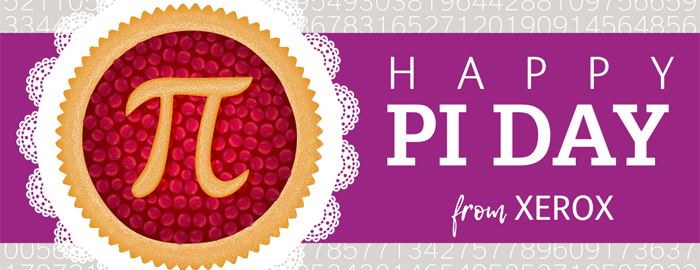March 14 (3/14) is the undeclared day of Pi (~3.14). Today, rational people around the world revel in this irrational number.
By Suzette Norris, Xerox contributor
Pi represents one of the most ancient numbers known to humanity. It is approximately 3.14159, the ratio of the circumference of a circle to its diameter.
Pi goes on forever, and apparently so does the affection that scientists, engineers, mathematicians and other number-minded folk have for the most famous ratio in mathematics.

“It is a fascinating number,” said George Gibson, a scientist at the Xerox Research Center Webster (XRCW). “The more you know about it, the more little quirks you find … some people have spent their lives studying it.”
And there will be lots of quirks to go around this Pi Day at XRCW, which will honor Pi and Einstein’s birthday with a potluck feast — of pie of course (sweet and savory).
Researchers also will be treated to games, competitions (How many digits can you recite?) and perhaps a showing of the Bohemian Gravity, a viral video created by a grad student who explains string theory to the tune of Bohemian Rhapsody with the help of an Einstein sock puppet.
“A love of math is a common denominator in our community,” George said. “Pi Day is a chance to channel our inner nerd and celebrate.”
XRCW is one of several Pi Day celebrations in the Rochester, N.Y area. The Rochester Museum and Science Center (where George serves as a board member) will hold a family celebration Friday starting at – 3:14 p.m. – of course.
And the Moonlight Creamery, an ice cream shop in nearby Fairport owned by XRCW’s business development manager Heidi Grenek, will raffle off ice cream pies to customers who can recite as many digits of Pi as possible. “We do this every year and have a huge following,” Heidi said. “We’re known as a pretty nerdy place.”




Do not believe the “irrational Pi” Conspiracy.
Pi is simply =4 as any rational person can easily proof:
take a sheet of math paper
mark an origin “O”
mark the set of points “P” that has equal distance from O remember, you are on math paper.
The circumference is the shortest path C through all members of set “P”.
measure the length – easy, math paper, just count the little lines
Pi = C/2R
Voila: Pi=4
I think Reiner’s answer might change if he considers the limit as spacing between graph lines -> 0.